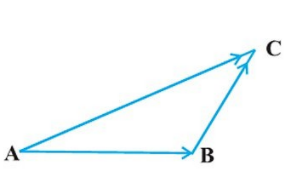State whether the following relations are true or false
(1)−−→AB=−−→BA
(2)−−→AB=−−−→BA
(3)∣∣∣−−→AB∣∣∣=∣∣∣−−→BA∣∣∣
(4)∣∣∣−−→AB∣∣∣=∣∣∣−−−→AB∣∣∣
(5)ˆj=ˆk
(6)∣∣ˆj∣∣=∣∣ˆk∣∣
The correct Answer is:(i) False (ii) True (iii) True (iv) True (v) False (vi) True
Let's analyze each of the statements one by one to determine whether they are true or false.
1. Statement (1): −−→AB=−−→BA
- Analysis: The vector −−→AB points from point A to point B, while −−→BA points from point B to point A. They have the same magnitude but opposite directions.
- Conclusion: This statement is False.
2. Statement (2): −−→AB=−−−→BA
- Analysis: Since −−→AB points from A to B and −−→BA points from B to A, we can say that −−→AB is indeed the negative of −−→BA. This means that if you reverse the direction of −−→BA, you get −−→AB.
- Conclusion: This statement is True.
3. Statement (3): ∣∣∣−−→AB∣∣∣=∣∣∣−−→BA∣∣∣
- Analysis: Both vectors −−→AB and −−→BA have the same magnitude because they represent the same distance between points A and B, regardless of direction.
- Conclusion: This statement is True.
4. Statement (4): ∣∣∣−−→AB∣∣∣=∣∣∣−−−→AB∣∣∣
- Analysis: The magnitude of a vector is always a non-negative quantity. Therefore, the magnitude of −−→AB is equal to the magnitude of −−−→AB, since both represent the same distance.
- Conclusion: This statement is True.
5. Statement (5): ˆj=ˆk
- Analysis: The unit vector ˆj represents the y-axis direction, while ˆk represents the z-axis direction. These are different directions.
- Conclusion: This statement is False.
6. Statement (6): ∣∣ˆj∣∣=∣∣ˆk∣∣
- Analysis: Both ˆj and ˆk are unit vectors, meaning their magnitudes are both equal to 1.
- Conclusion: This statement is True.
Final Summary of Statements:
1. False
2. True
3. True
4. True
5. False
6. True
- Analysis: The vector −−→AB points from point A to point B, while −−→BA points from point B to point A. They have the same magnitude but opposite directions.
- Conclusion: This statement is False.
- Analysis: Since −−→AB points from A to B and −−→BA points from B to A, we can say that −−→AB is indeed the negative of −−→BA. This means that if you reverse the direction of −−→BA, you get −−→AB.
- Conclusion: This statement is True.
- Analysis: Both vectors −−→AB and −−→BA have the same magnitude because they represent the same distance between points A and B, regardless of direction.
- Conclusion: This statement is True.
- Analysis: The magnitude of a vector is always a non-negative quantity. Therefore, the magnitude of −−→AB is equal to the magnitude of −−−→AB, since both represent the same distance.
- Conclusion: This statement is True.
- Analysis: The unit vector ˆj represents the y-axis direction, while ˆk represents the z-axis direction. These are different directions.
- Conclusion: This statement is False.
- Analysis: Both ˆj and ˆk are unit vectors, meaning their magnitudes are both equal to 1.
- Conclusion: This statement is True.
1. False
2. True
3. True
4. True
5. False
6. True
Topper's Solved these Questions
- RACEBOOK - ALLENCHAPTER - RACEEXERCISE - Basic Maths (Units, Dimensions & Measurements)
30 Videos
- RACEBOOK - ALLENCHAPTER - RACEEXERCISE - Basic Maths (KINEMATICS)
59 Videos
- RACEBOOK - ALLENCHAPTER - RACEEXERCISE - Basic Maths (Co-ordinate & Algebra)
37 Videos
- NEWTONS LAWS OF MOTIONBOOK - ALLENCHAPTER - NEWTONS LAWS OF MOTIONEXERCISE - EXERCISE-III
28 Videos
- SIMPLE HARMONIC MOTIONBOOK - ALLENCHAPTER - SIMPLE HARMONIC MOTIONEXERCISE - Example
1 Videos
Similar Questions
In triangle ABC (Figure), which of the following is not true:
(A)−−→AB+−−→BC+−−→CA=→0
(B)−−→AB+−−→BC−−−→AC=→0
(C)−−→AB+−−→BC−−−→CA=→0
(D)−−→AB+−−→CB+−−→CA=→0

View SolutionIn a quadrilateral ABCD, −−→AB+−−→DC=
View SolutionIf ABCDEF is a regular hexagon, prove that −−→AC+−−→AD+−−→EA+−−→FA=3−−→AB
View SolutionProve that (→A+2→B).(2→A−3→B)=2A2+ABcosθ−6B2.
View SolutionIf I is the centre of a circle inscribed in a triangle ABC, then ∣∣∣−−→BC∣∣∣−→IA+∣∣∣−−→CA∣∣∣−→IB+∣∣∣−−→AB∣∣∣−→IC is
View SolutionIf A,B,C,D are any four points in space prove that −−→AB×−−→CD+−−→BCx−−→AD+−−→CA×−−→BD=2−−→AB×−−→CA
View SolutionIf →A=ˆi+ˆj and →B=ˆi−ˆj
The value of (→A+→B).(→A−→B) is :
View SolutionIf ABCDE is a pentagon, then
−−→AB+−−→AE+−−→BC+−−→DC+−−→ED+−−→AC is equal to
View SolutionIn a regular hexagon ABCDEF, prove that −−→AB+−−→AC+−−→AD+−−→AE+−−→AF=3−−→AD
View Solution−−→ACand−−→BD are the diagonals of a parallelogram ABCD. Prove that
(i)−−→AC+−−→BD−2−−→BC
(ii) −−→AC−−−→BD−2−−→AB
View Solution
